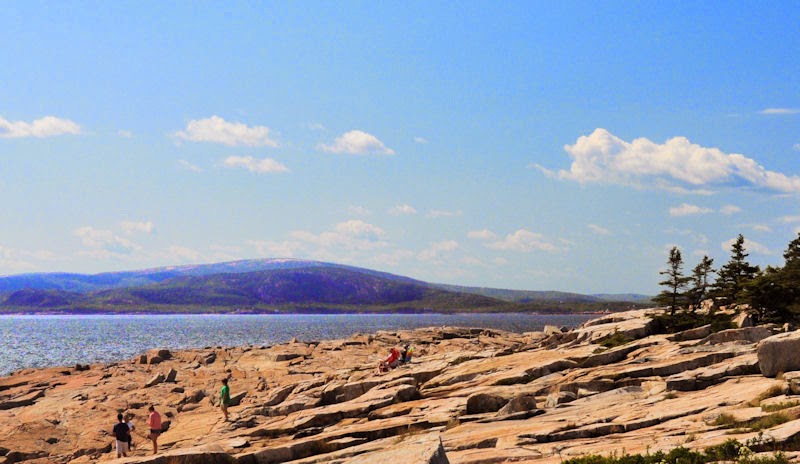 |
| Acadia National Park - nice enough I guess |
 In 1872, through an act of congress, Yellowstone became the first National Park in the United States, or the world for that matter. The second was Mackinac Island in Michigan, but after a few years the good people of Michigan asked for that one back, so it was released from federal custody and is now a Michigan State Park, however other locations had been added to the list in the meantime. Between 1872 and 1919 the National Park Service grew to include Yosemite, the Grand Canyon, Crater Lake, Mt. Ranier, Sequoia, Denali in Alaska, Haleakala in Hawaii, Wind Cave in the Black Hills, Rocky Mountain and Glacier National Parks, the Mesa Verde cliff dwellings and Mount Lassen in California. Thirteen National Parks and they all had one thing in common. They were all west of the Mississippi River. Whereas the vast majority of US citizens were not. And they were getting pretty fed up about it.
In 1872, through an act of congress, Yellowstone became the first National Park in the United States, or the world for that matter. The second was Mackinac Island in Michigan, but after a few years the good people of Michigan asked for that one back, so it was released from federal custody and is now a Michigan State Park, however other locations had been added to the list in the meantime. Between 1872 and 1919 the National Park Service grew to include Yosemite, the Grand Canyon, Crater Lake, Mt. Ranier, Sequoia, Denali in Alaska, Haleakala in Hawaii, Wind Cave in the Black Hills, Rocky Mountain and Glacier National Parks, the Mesa Verde cliff dwellings and Mount Lassen in California. Thirteen National Parks and they all had one thing in common. They were all west of the Mississippi River. Whereas the vast majority of US citizens were not. And they were getting pretty fed up about it.At the dawn of the 20th century, getting from New York or Boston to the Yosemite Valley was no simple matter. Most people could not take a couple of weeks off to cross the country on a pleasure trip. They wanted something a little closer to home.
 |
| Bar Harbor from atop Cadillac Mountain |
Carnegies, and Astors, who came and built "cottages", which were actually luxurious mansions with dozens of rooms where the families could spend vacations in pseudo-rustic surroundings. One of these super-affluent vacationers, George B. Dorr, became obsessed with
 |
| Cruise ship at Bar Harbor |
Today Acadia National Park covers more than 47,000 acres and is the second most visited park in the system, but I think this is primarily due to its proximity to
 |
| Frenchman Bay |
The closest thing they have is Cadillac Mountain, which is never mentioned without adding that it is "the highest Mountain on the East Coast." I suppose that's true if you narrowly define "East Coast" as extending only a couple of miles from the Atlantic Ocean. But this "mountain" is only 1550 feet above sea level (give or take 10 feet depending on the tide). That's barely a foothill. Our home in Redlands was higher than that and we were considered flatlanders.
 |
| Sand Beach with piles of rotting seaweed |
 |
| Mighty Cadillac Mountain from the far side of the harbor |
In fairness, there are obviously summer crowd problems at other parks but at someplace like Zion or Yellowstone we think the scenic payoff is better. Our initial impression of Acadia is that it could be nice but in the current reality it is not worth the aggravation.
Oh, and as long as I am griping...
We drove to Ellsworth, the nearest town of any size, to see Guardians of the Galaxy. It was a fun movie and deserves all the good press it has gotten. But the theater in Ellsworth was a disaster. It is set up in what appears to be previously unrented store space in a modest strip mall. The screen was really too small for the room, not filling enough of the viewer's visual field to give a real theater experience. In spite of that, they kept the projector under powered (which exhibitors do to try and lengthen the life of the projector bulb) so the picture was dim and murky. Worst of all, it seemed like they were playing the 7 channel surround sound on only 2 channels, so the actors would fade in and out depending on where the character was standing in the shot. We missed a good portion of the dialog. I guess being located just outside a National Park, they figure they don't have to rely on repeat business. Had we known, we would have driven the extra 20 miles to Bangor.
Last winter we spent three months working on the Navajo reservation in Arizona. After a few months to sort through her feelings about it, Vicki has written up her impressions of the experience which we will be including in segments over the next few posts
We Be City Folks: Working in Chinle
By Vicki Rains
 |
| Our vacant lot in Chinle |
 |
| Just outside the motorhome door |
 |
| The neighbors |
 |
| Benefits of free wandering livestock |
 |
| Not a feral dog but a reasonable facsimile |
No comments:
Post a Comment